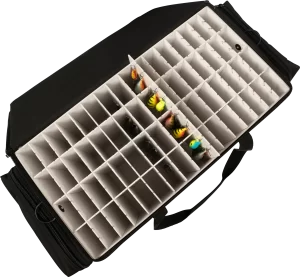When it comes to fishing gear, having a reliable tackle box is essential. But not all tackle boxes are created equal, and choosing between a soft or hard tackle box can make a big difference in how efficiently you fish. As gear and techniques evolve, so does the demand for the right type of storage solution. Whether you’re a seasoned angler or just getting into the sport, understanding the pros and cons of each type will help you make an informed decision.
Durability and Protection
Hard Tackle Boxes: Built to Last
Hard tackle boxes are known for their rugged construction. Made from durable plastic or metal, they’re designed to withstand rough conditions, making them ideal for anglers who frequently fish in demanding environments. Whether you’re dealing with rocky shorelines, long hikes, or simply the wear and tear of constant travel, hard tackle boxes offer superior protection for your gear.
The rigid exterior keeps lures, hooks, and reels safe from impact damage, and many models feature reinforced corners for added strength. Additionally, hard tackle boxes often come with waterproof or water-resistant features, ensuring that your gear stays dry in the event of rain or accidental splashes. For those who value maximum protection for their expensive equipment, hard tackle boxes are the go-to option.
Soft Tackle Boxes: Flexibility and Comfort
On the other hand, soft tackle boxes are made from heavy-duty fabrics like nylon or polyester. While they may not offer the same level of impact resistance as hard boxes, they excel in flexibility and comfort. Soft tackle boxes are lightweight and easy to carry, often featuring padded shoulder straps or handles for added convenience.
Though soft boxes lack the rigid structure of their hard counterparts, many models come with internal support systems, providing a decent level of protection for your gear. They may also have water-resistant coatings to keep your equipment dry during light rain. However, in terms of pure durability, soft tackle boxes are better suited for less harsh conditions, making them a popular choice for casual anglers.
Storage Capacity and Organization
Hard Tackle Boxes: Compartmentalized for Maximum Organization
Hard tackle boxes typically come with multiple compartments and trays, offering a high level of organization. These boxes are designed with pull-out trays or cantilever systems that give anglers easy access to their gear. The rigid compartments help keep lures, sinkers, and other equipment neatly separated, reducing the risk of tangling or damage.
The organizational benefits of hard tackle boxes make them perfect for anglers who carry a wide variety of tackle. With dedicated spaces for different types of gear, everything stays in its place, allowing for quick changes when needed. This feature is especially useful when targeting multiple species of fish, as it enables quick access to specific lures and hooks.
Soft Tackle Boxes: Customizable and Spacious
Soft tackle boxes, however, excel in adaptability. Unlike hard boxes, which come with fixed compartments, soft tackle boxes often feature removable dividers or modular storage systems. This flexibility allows anglers to customize the layout based on the specific gear they’re carrying that day. Some soft tackle boxes also have external pockets, which provide additional storage for tools, personal items, and even snacks.
Soft boxes tend to offer more overall storage space, especially when considering their external compartments. The ability to adjust storage configurations makes them ideal for anglers who frequently change their tackle setups or who want to carry additional accessories, such as pliers, scissors, or sunscreen.

Portability and Convenience
Hard Tackle Boxes: Sturdy but Bulky
While hard tackle boxes offer excellent protection and organization, they can be bulky and less convenient to carry, especially on longer trips. Most hard tackle boxes come with a handle for easy transport, but their weight and size can become a hindrance, particularly if you need to hike to a remote fishing spot.
Soft Tackle Boxes: Lightweight and Easy to Carry
Soft tackle boxes, on the other hand, are built with portability in mind. Their lighter weight and flexible design make them much easier to carry over long distances. Additionally, many models come with backpack-style straps or shoulder slings, allowing for hands-free transport. For anglers who like to fish in a variety of locations, from shorelines to boats, soft tackle boxes offer superior mobility.
Price and Affordability
Hard Tackle Boxes: Higher Initial Investment
Because of their durable construction and added protection, hard tackle boxes tend to be more expensive than their soft counterparts. However, they are often seen as a long-term investment due to their longevity and robust build. If maximum protection is a priority, the higher cost of a hard tackle box is worth considering.
Soft Tackle Boxes: Budget-Friendly Options
Soft tackle boxes generally come at a lower price point, making them a more affordable option for anglers on a budget. While they may not last as long in tough conditions, their lightweight design and customizable storage make them a great value for those looking to fish casually or in less demanding environments.
Choosing between a soft and hard tackle box ultimately depends on your fishing style and needs. For those seeking durability, protection, and detailed organization, a hard tackle box is the way to go. However, if flexibility, portability, and affordability are more important, a soft tackle box may be the better choice.’
Image: lakewoodproducts





